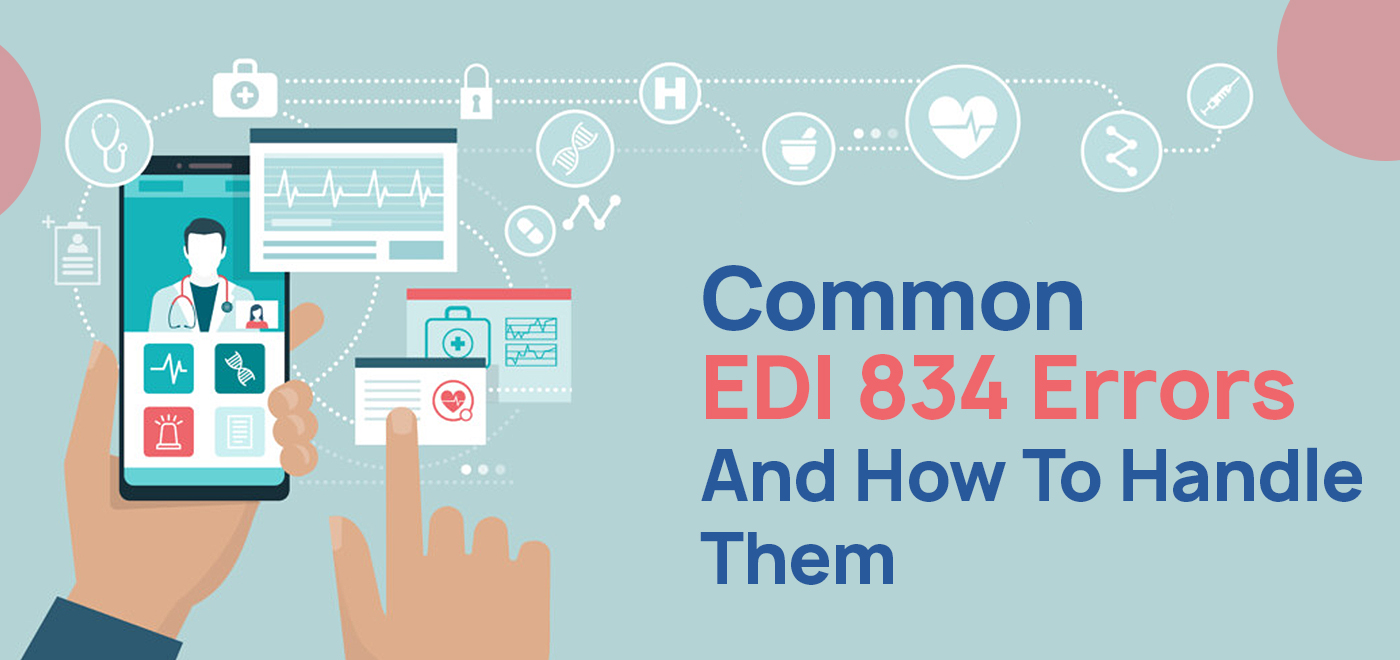Electronic Data Interchange (EDI) 834, or just EDI 834 File, is a rule set by the Accredited Standards Committee (ASC) X12. It’s how insurers get enrollment data. It’s a digital lingo that lets firms communicate using a common, simple format.
834 EDI, a specific format, is key for sending healthcare enrollment details from employers to health insurers or government to managed care groups. It holds all needed data for successful health plan sign-up, including the person’s details, their chosen plan, and their dependents, if any.
Importance of EDI 834 File in Healthcare
EDI 834 File, seen as the bedrock of healthcare data interchange, is crucial for smooth flow in healthcare. Let’s see why it’s so vital.
First up is speed. 834 EDI offers quick and errorless communication between different healthcare players. Therefore, by making a uniform way to send enrollment data, it cuts manual entry, thus lowering errors and quickening process times.
Next, it boosts correctness. When folks manually enter data, errors can occur – typos, misreading info, or putting data in the wrong spots. 834 EDI lessens such cases by offering a standard form for data entry, making sure the right info goes in the right spots.
Plus, 834 EDI encourages working together. Given the mix of insurance firms, employers, and government in health plan sign-up, a standard language that all systems can get is key. 834 EDI is this language letting different systems talk with each other with ease.
Lastly, 834 EDI helps in keeping rules. Health plan sign-ups often have private and medical details, needing strict rules around privacy. Hence, by offering a standardized and safe way to send this data, 834 EDI helps all players follow these rules.
EDI 834 File
Key Components of EDI 834 File
An 834 EDI file is full of parts that form a full image of a person’s sign-up info.
The first key part of an EDI 834 File file is the ‘Header.’ It gives key info about where the file started and where it’s going. It tells us when it was made and the unique control numbers. It’s like giving key details about who sent and who’ll receive it.
Then we have the ‘Member Level’ info. This part holds data about individuals. It contains personal details like the member’s name, birth date, gender, and address. Assume this part as the member’s identity card for the health plan.
The third key piece is the ‘Health Coverage Level.’ This part gives a clear image of the health plan picked by the member. It details the coverage type, when it starts and ends, and key codes for the plan. See this as the blueprint of the member’s chosen healthcare plan.
Last, we have the ‘Trailer.’ This part confirms the segments or entries in the file. It checks the data transferred is full and right, like the final tick on a finished job.
Role of EDI 834 File in Benefits Enrollment
Now that we’ve learned the parts of an 834 file, let’s find out its role in benefits sign-up.
834 EDI is like the invisible star that makes the benefits sign-up process smooth. It’s at the heart of the electronic interchange of sign-up data between entities involved, like employers, insurance carriers, or government bodies.
One key role 834 EDI plays is in making the sign-up process automatic. Think of trying to write thousands of letters by hand when you can send emails. The old manual sign-up process is similarly slow and full of errors. 834 EDI automates this process, making it faster and reducing errors.
Next, 834 EDI makes sure that all data interchanged is standard and the same, no matter the insurance carrier or employer. It forms a shared language every system can understand, making communication easier.
Lastly, EDI 834 File is key in keeping to regulations. In healthcare, where sensitive data is often interchanged, it’s key to make sure the process is safe and sticks to privacy laws. 834 EDI gives a standard and safe way of data transmission, helping entities stay within the law.
Common EDI 834 File Errors
The 834 EDI, despite its incredible aid in streamlining benefits signup, isn’t perfect. Errors might happen, and in this part, we’ll be delving into ordinary errors that might occur in an 834 Transaction and spotting them.
Incorrect Member Identification
Errors in identifying members often trigger serious trouble in 834 EDI processing. Like wrongly addressed letters sparking confusion, incorrect member data can cause postponed or mistaken benefit signup. Such errors generally happen in ‘Member Level’ info and can involve wrong member names, misstated social security numbers, or wrongly keyed dates of birth. Making sure these details are precise is crucial to maintain a seamless and error-less signup process.
Invalid or Missing Dates
Consider dates in EDI 834 File as timeframes that track a member’s signup journey. Wrong or absent dates can disturb this journey, leading to potential confusion and inconsistencies. This may include incorrect coverage start and end dates or missing such vital dates altogether. For an 834 Transaction, verifying these dates for each member to stop any misunderstanding or miscommunication about the coverage time is critical.
Inconsistencies in Health Plan Details
A mismatch in health plan details in an 834 file can lead to significant errors. These mismatches might involve misaligned health plan codes, wrong benefit amounts, or discrepancies in coverage kinds. Checking all health plan details is key to a clear and seamless journey in benefits signup.
Incorrect Provider Information
An error in provider info within an EDI 834 Filefile can create a lot of confusion, like dialing the wrong number and hoping to reach the right person. This could be due to the wrong input of provider names, addresses, or identifiers. It’s like reaching the wrong healthcare provider for a member’s care, causing service delivery issues and potential dissatisfaction. Confirming all provider info is crucial to make sure accurate and efficient signup.
Lack of Compliance with EDI Standards
Not adhering to EDI standards when processing an 834 EDI Transaction can be equated to playing a game without following the rules. The outcome is confusion, errors, and a disrupted process. Also, compliance issues could involve failure to use the correct version of the 834 EDI standard, incorrect use of data segments, or failure to follow the standard sequence of data.
The Impact of 834 EDI Errors on Health Care Operations
Healthcare operations can face huge challenges due to EDI 834 File blunders. Issues like enrollment delays and unexpected money problems arise from these errors. This section sheds light on how 834 EDI errors can affect healthcare operations.
Potential Setbacks in Health Plan Enrollment
The main goal of the 834 transactions is to make sign-ups to health plans easy and quick. But when errors happen, this process hits major roadblocks.
These delays can cause late or incorrect sign-ups, making things tough for the member and the healthcare provider. Members might lose out on important coverage or perks, while providers might have to use more resources to fix these problems, hurting their efficiency.
Unanticipated Financial Implications
Apart from affecting the sign-up process, EDI 834 File errors can also lead to money problems for healthcare providers.
Firstly, fixing errors means spending extra time and resources. This might involve re-doing 834 files, manually correcting errors, or even talking to members to verify their information. All these tasks mean more operational costs for the provider.
Secondly, wrong or mismatched health plan details could cause financial losses. For example, if a member is wrongly signed to a pricier plan, the provider might have to pay the extra cost. Or, if a member is wrongly denied services due to an 834 EDI error, the provider could face monetary damages or fines.
Lastly, failing to follow EDI standards, which often causes many 834 EDI errors, could lead to legal issues and potential fines. These money problems highlight the need for accurate and compliant 834 transactions as part of solid open enrollment solutions.
Strategies for Handling 834 EDI Errors
Grasping 834 EDI errors is the first rung of the ladder. The steeper climb is finding effective ways to deal with them. You might see these approaches as a medic’s solution to fix the symptoms and the root of our EDI 834 File problems. Here, we’ll look into various tactics to manage 834 errors, including data checking, using the right EDI tools, and training folks in 834 best practices.
Regular Data Validation
As routine health exams keep us fit, so regular data checking is key to an error-free 834 EDI process. This checking is like a safety net against 834 EDI errors. It means making sure the data is correct and complete before it’s sent in the 834 EDI document. For example, confirming member IDs and dates can stop ‘Wrong Member ID’ and ‘Missing or Wrong Dates’ errors. Think of data checking as a final look-over before a product goes out. It makes sure the 834 EDI document we send follows HIPAA EDI 834 standards and has no errors.
Utilizing Proper EDI Management Tools
Handling EDI 834 File tasks can be hard, but the right tools make it easier. These tools offer features like spotting errors as they happen, automatic fix capabilities, and full reports. This means errors in the 834 EDI document can be found and fixed fast, reducing the chance of these errors affecting enrollment. Plus, these tools help you stick to HIPAA 834 standards, helping you avoid legal issues.
Training Staff in EDI 834 Best Practices
You can’t ignore the manual part of handling 834 EDI tasks. Here, training is key. Training staff in 834 EDI best practices is like giving them a guidebook to understand and manage 834 EDI tasks right. This training should include things like understanding 834 EDI document parts, the need for data accuracy, and how to use EDI tools. Basically, it gives staff the skills and knowledge to manage 834 EDI tasks and avoid common errors.
Best Practices to Avoid 834 EDI Errors
Recognizing and managing errors is vital. However, our focus must not waver from prevention. Truly, averting 834 EDI errors from the start is the best method to ensure flawless health plan sign-ups. Businesses can embrace certain key strategies to forestall 834 EDI errors. Here, we’ll discuss three main strategies – applying thorough error reporting, routine audits of EDI transactions, and staying updated on EDI norms.
Implementing Comprehensive Error Reporting
A vital strategy is applying thorough error reporting. It’s akin to having a health tracker continuously screening the system for any signs of ailment. When talking about 834 EDI dealings, thorough error reporting allows businesses to spot and pinpoint likely errors before they lead to serious issues.
Error reporting doesn’t just mark errors but also offers deep insights into their roots. This enables businesses to fix not just the errors but also their root problems. Hence, by teaming up with reliable EDI 834 service providers, businesses can leverage powerful tools that deliver thorough error reporting.
Regular Audits of EDI Transactions
Routine audits of EDI transactions act like preventive health check-ups, spotting abnormalities and ensuring the system’s well-being. Audits enable businesses to scrutinize their EDI 834 File dealings in detail, spotting and addressing any irregularities that might result in errors.
An exhaustive audit covers every part of the transaction – from the correctness of the data to the legitimacy of the transaction formats. Hence, by conducting these checks, businesses can notably reduce the chance of errors seeping into their 834 EDI dealings. Routine audits, thus, constitute an essential part of a forward-looking approach to handling 834 transactions.
Ensuring Up-to-Date Knowledge of EDI Standards
The EDI world, much like any tech field, keeps changing. As such, staying updated on EDI norms is like keeping tabs on the latest medical research to stay fit. In the context of 834 EDI dealings, it is vital to grasp the latest HIPAA rules and guidelines.
Shifts in these norms can greatly influence the framework and prerequisites of 834 EDI documents. Hence, businesses must ensure they’re well informed about any changes and modify their processes accordingly. This can avoid a range of errors tied to non-adherence with the revised norms.
Future of 834 EDI – Towards Error-Free Transactions
As we step forward, the electronic data interchange (EDI) scene keeps changing. With tech improving rapidly, there’s a growing trend toward making these systems work better and faster. For 834 EDI, the standard used in health plan sign-ups, this future means no more errors. In this part, we’ll look at new things happening in EDI tech and how tools like AI can help stop EDI errors.
Emerging Trends in EDI Technology
In a world moving more online, EDI tech isn’t left behind. EDI 834 File and EDI overall are changing to suit the needs of businesses. In this, top EDI providers play a key role as they guide the change.
A big trend is moving towards cloud-based EDI solutions. These options are easier to scale, flexible, and cost less, breaking down old limits set by in-house systems. Moving to the cloud allows for real-time data work and sending, making work quicker and cutting down on errors in 834 EDI deals.
Another trend is making EDI work with other business systems, like planning (ERP) and customer management (CRM). This full-view method gives better control over data, leading to more correct and fast deals.
Role of AI and Machine Learning in Mitigating EDI Errors
In the search for no-error deals, we can’t forget the power of AI and machine learning. These tools can be like a lighthouse, guiding us toward a future of smooth, error-free 834 EDI deals.
AI and machine learning can make EDI deals better and faster, catching patterns and strange things that might slip past us. For example, machine learning can guess possible errors in 834 EDI deals using old data. Businesses can now identify and rectify mistakes before they escalate into significant issues. Furthermore, artificial intelligence can assist in automating error detection and correction procedure. This reduces human effort and enhances operational efficiency.
Therefore, the evolution of 834 EDI hinges on constant improvement and adaptation. The latest developments in EDI technology, coupled with the influence of artificial intelligence and machine learning, are sculpting this future. They guide us toward achieving flawless transactions. As we take in and use these changes, the way we handle 834 EDI deals will keep getting better and more accurate, letting us focus on what’s really important – providing quality health services.
Conclusion
Key Takeaways on the Vital Role of Precise 834 EDI Operations
Throughout this journey, we’ve decoded the intricacies of EDI 834, the transaction set crucial for health plan enrollments. these transactions are the core of effective health plan management. Precise transactions guarantee streamlined enrollment processes, suitable benefits management, and accurate premium billing. It works like a well-functioning engine, where every component plays a key role in ensuring optimal overall operation.
On the other hand, errors in 834 operations can create disruptions, financial troubles, and compliance challenges. These errors are like hurdles on a smooth path, causing delays, irritations, and at times, even mishaps.
Final Reflections
Avoiding and managing EDI 834 File errors isn’t a universal solution. It demands a mix of technological skill, knowledge, and watchfulness. Adopting comprehensive error reports, performing regular audits, and keeping up-to-date with EDI rules are tactics businesses must employ. Simply put, it mirrors the approach to maintaining good health. Just as a balanced diet, regular exercise, and regular health checks are essential for our well-being, these tactics are for EDI 834 management.
The future of 834 is bright, with the advent of new technology, artificial intelligence, and machine learning steering us toward operations without errors. This future is not a far-fetched dream but a realistic possibility, provided we have the correct tools, strategies, and procedures.
As we initiate this journey, we get the chance to shape the future of healthcare enrollment with accurate and effective 834 processes. Therefore, let’s embark on this path, learn from our past mistakes, and target a future with smooth, error-free EDI practices.
Wrapping up, remember the future of 834 EDI is in our control. Every stride towards error-free operations takes us nearer to a healthcare system offering seamless experiences for all. So, let’s endeavor to understand the language of 834 EDI and establish the foundation for a more efficient, error-free healthcare enrollment procedure. Though the path may be tough, the end goal is definitely worth the struggle.
Are you set to take this journey? Contact Toporgs today for extra assistance and support in handling your EDI 834 operations effectively. Because ultimately, our goal is to offer the best care, and that begins with mastering the nuances of 834 EDI.
FAQs
What is an EDI 834 error, and why does it matter?
834 EDI is a standard format used in health care. It helps to share important enrollment information. Imagine it as a special code for passing on vital data. If there’s an error in an 834 EDI exchange, it means the shared data is incorrect.
The significance of an EDI 834 error relates to the value of the data. Even a small mistake in EDI 834 data can cause billing errors, wrong enrollment, and other issues. These can affect how healthcare services are delivered.
What are the common types of EDI 834 errors?
There are many types of 834 EDI errors. These are similar to the errors we can make when talking. The usual ones are wrong member details, incorrect plan data, faulty dates, or incomplete data. It’s similar to sending mail with the wrong address. Chances are it won’t reach the right person.
How can EDI 834 errors impact healthcare operations?
Errors in 834 EDI can upset healthcare operations. It can cause wrong plan enrollments, billing problems, and possible legal issues. The fallout is not only money-related but can also impact patient care and faith in the healthcare system.
What are some strategies for handling EDI 834 errors?
Dealing with 834 EDI errors needs a good strategy. Regular data checks, the use of the right EDI management tools, and training staff on 834 EDI are key methods to handle these errors.
What are the best practices to avoid EDI 834 errors?
Some best practices are thorough error reporting, regular checks of EDI transactions, and keeping current with EDI standards.




